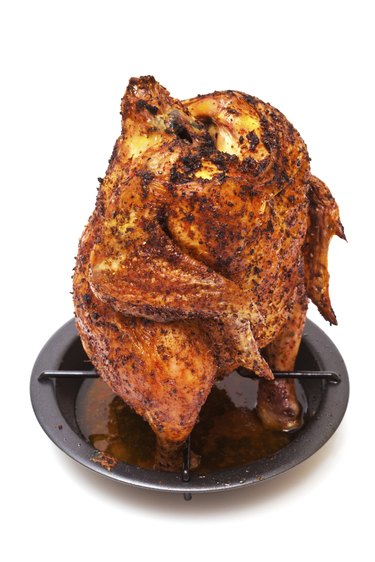
Few things improve on the simple perfection of a roast chicken, largely because it doesn't need embellishment -- anything other than a fresh herb or two is often superfluous. Vertical roasting is the exception. Vertical roasters hold chicken upright during cooking, so the very bottom of the bird receives as much exposure to the hot, crisping air as the top does. The result: a comprehensively browned, thoroughly crisp chicken that's as uniformly cooked in the breast as it is the thigh. If you don't have a vertical roaster, no problem; use a bundt pan.
Chicken Prep
Video of the Day
Unlike horizontal roasting, you don't have to truss the chicken for vertical roasting. Other preparations, such as seasoning and trimming, are the same.
Video of the Day
Remove the giblets and neck from the cavity and reserve it for stock. Cut off the "pope's nose" -- the fleshy protuberance above the cavity at the rear of the bird -- so the chicken can sit flat on the roaster. Dry the chicken all over with paper towels, and coat it with a thin layer of oil and season it to taste.
For extra-crisp skin, let the chicken sit in the refrigerator uncovered in a shallow dish for 24 hours. This produces a taut, crisp skin redolent of Peking duck.
Optional Vegetables
Roasting vegetables along with the chicken isn't mandatory; it doesn't affect the quality of the chicken, but not taking advantage of the rendered fat and juice that trickles down the bird breaks a culinary commandment: Make the most of every ingredient. Loading chopped vegetables into the roaster reservoir puts them in prime position to receive a flavorful fat-and-stock shower that crisps them as they cook.
Chop a few cups of vegetables, enough to fill the reservoir by one-half to three-fourths. Coat the vegetables in a light sheen of oil, just enough to keep them from drying before the fat starts rendering from the chicken. Season the vegetables to taste with kosher salt and pepper and spread them out in the roaster.
Roasting
Set the oven to 450 degrees Fahrenheit. The oven rack should sit at the lowest level. Place the roaster on the oven rack; if you're using a bundt pan, set it on a baking pan to catch the drippings from the chicken cavity. When the oven reaches 450 F, slide out the rack and carefully set the chicken on the roaster's spike.
Roast the chicken for 15 minutes to start the sear; then lower the oven to 350 F. Roast the chicken for 40 minutes and check the temperature in the center of a breast using an instant-read thermometer. When the breast reaches 160 F, increase the oven temperature to 450 F and cook the chicken another 5 minutes for a final crisping.
The Finish
Using a kitchen towel for grip, lift the chicken off the roaster and set it on a plate to rest for 5 to 10 minutes. Next, take the roaster from the oven and remove the vegetables using a slotted spoon. While the chicken rests, use the rendered fat and juices, now aromatized with the fragrance of roasted vegetables, to make a classic gravy.